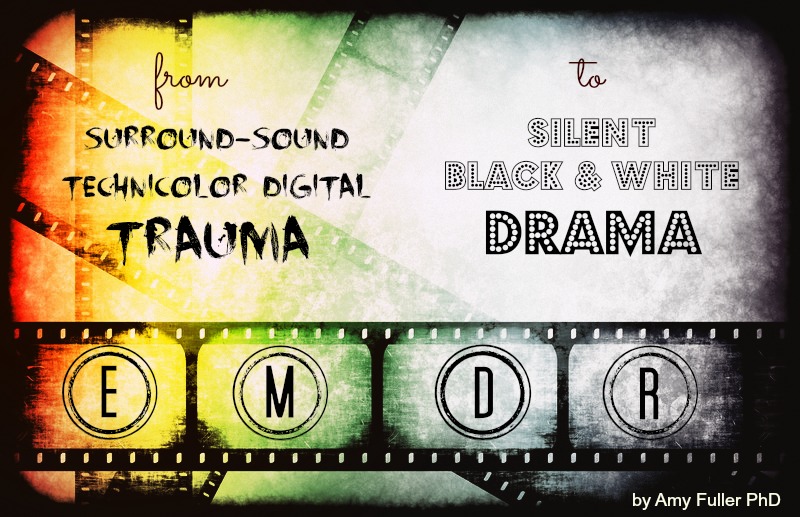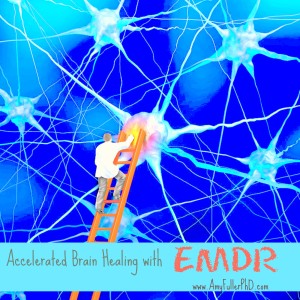EMDR Therapy: From surround-sound technicolor trauma to silent black & white drama
For those of us having the luxury of watching color television our entire lives, classic black and white movies can be challenging in spite of the fact that many of these films offer a much richer narrative. In today’s digitally-powered culture, we find the current premium digital experience more sensually appealing and mesmerizing.
The opposite is true when it comes to our own real-life drama and memories. We want to recall good memories with vibrant color and detail and let old or “bad” memories fade into a colorless non-existence. But our brains tend to hold onto any memory that is paired with a strong emotion, be it positive or negative. EMDR therapy has the power to make the positive experiences stronger and the traumatic memory weaker. Read on if you want to know how this happens!
Our memories color our world
Over time, the day-to-day memories of our lives tends to fade into something far away or “just something that just happened.” This occurs naturally as our brain sorts out our experiences turning some into long-term memory or learning, and simply deleting those insignificant things we don’t need to remember like where we parked our car at the grocery story. As we sleep our brains go into a sort of housekeeping mode and the raw footage of the day is edited. The sights, smells, thoughts, feelings, and experiences are sorted and coded in a systematic nature. This encoding process is quite complex and involves different types of autobiographical memory that shapes our sense of who we are and our value.
These memories and what they mean determine what we believe about ourselves, our lives, and our world. We are, in our own self-perception, the interpretation of the sum of our experience. In our rear view mirror we see who we are, or at least who we think we are since the mirror is most often distorted in one way or another. When it comes to memory, perception is reality, and yet our brain doesn’t just record the facts…what matters most is the feeling.
The more we feel it the more we recall it.
The more emotion involved in any particular experience the more we will remember about that experience. Much research has shown that if an experience invokes a high degree of emotion, either positive or negative, the the memory will be recalled more often and with greater detail or clarity. This is a desirable phenomenon for our positive memories. We like the idea of recalling moments of joy, celebration and victory with great detail. We want to remember the moment we first met our loved one, the birth of our children or the sweet victory of a high school championship.
Yet memories of pain, suffering or trauma, can detrimentally effect our ability to live well. Since memories of abuse or tragic loss are almost always accompanied with strong emotions such as shock, fear, terror, etc. our brain will hold onto these memories and sometimes they can become “trapped” or “frozen” before they go through the encoding process. This can lead to flashbacks, night terrors and disassociation. Until these memories are healed, they continue to affect our sense of self, worth and behavior in ways that are most often out of our awareness.
The movies in our minds
Traumatic memories that remain “unprocessed” are like horror films that keep replaying in the mind. Not only are they re-lived in the mind, but the body remembers as well. The punch or rape that happened years ago seems to be happening in the present moment of the flashback. Additionally, the recurrence of these memories reinforces the erroneous beliefs we hold about ourselves because of the memory. For example, when a child is abused the common belief is “It’s my fault” or “I must have been bad.” Reliving these memories makes this seem more true, when it couldn’t be further from the truth.
Since our brains #1 job is to keep us alive, the brain is constantly on guard for anything that even remotely looks, feels, tastes, sounds or smells like that awful event. These “triggers” for negatively charged memories are front and center for our threat detection system. If our brain was a computer theses sensory triggers would live on our desktop. In order to protect us, the brain is hyper-vigilant about making sure something like “that” never happens again. The problem is the brain is not very good at knowing the difference between real vs. perceived threat. If one dog bites a child, the child believes all dogs will bite them. The smell of alcohol can trigger the breath of a rapist from 15 years prior. A loud sound can bring back images of war.
Not all triggers are from Capital “T” kinds of Trauma. Even small things that wound or hurt us, with a lower-case “t” for trauma, can create the same “triggering” response. The look on someone’s face can remind you of a time you felt really hurt by that person. Any negative memory paired with an undesired emotion can result in a “trigger” point and false belief about one’s value.
When the brain perceives danger it automatically goes into overdrive, or what we call the “fight or fight” response. Born purely from self-protection our heart-rate increases, eyes dilate and super-powered hormones are released into the body. When it turns out to be only perceived threat, we have left-over stress hormones that not only make us fat, but make us feel awful. Under normal circumstances, we have less “real” threat in our modern civilized society than we did millions of years ago. Without laws and cities to keep real threat at bay, our ancestors needed that animalistic instantaneous response to danger so they could survive. Today, we have the luxury of well-secured city zoo’s if we want to encounter the kind of danger they lived with every day. That said, it’s important to remember that our brain is only doing it’s job and working very hard to protect us when we are awake and heal us when we are asleep.
Our brain is always trying to heal itself
As stated above, the brain at rest, is constantly reorganizing and cleaning house. So those “frozen” memories are sometimes pulled out of the DVD cabinet and viewed for processing as the brain tries to make sense of the experience. When a memory has been fully processed, it is transformed from traumatic memory to meaning memory (from episodic memory to semantic memory). REM sleep is a critical part of this transformation. The problem is the brain must completely down-regulate the neurotransmitter system in order to go into REM sleep and this is challenging when sorting through events that don’t make sense. Sometimes traumatic memories heal on their own this way. Sometimes we just have nightmares. Either way, the brain will continue to try to heal itself.
EMDR therapy is one way these memories are healed quickly and intentionally. Instead of waiting on the natural healing, we consciously address and process the painful experience. While the treatment requires great effort and courage on behalf of the client, the results can be instantaneous and profound. Applying eye movements (or bi-lateral stimulation of the brain simulating REM), desensitizes the memory, experience or feeling. What has not yet happened in the encoding process occurs while we are awake and the emotional color of the memory begins to fade. What bothers someone at a 9 on a scale of 1 to 10 can in 10 minutes only bother them at a 2. While it sounds too good to be true, much research has proven EMDR to be the preferred treatment for PTSD (Post-traumatic Stress Disorder).
EMDR does not erase the memory or make it never to have happened, it simply resets the emotional charge to neutral. This means instead of reliving horror movies with all the bells and whistles, we gain more objective distance from the event. Old triggers no longer have the power to make us react in ways inconsistent with who we are. A dog is just a dog and a loud sound is just a loud sound. The emotional color has been drained from the memory and reset to neutral or sometimes even to a more positive and empowering way of viewing the tragedy. We are then free to decide what we believe about ourselves from a place of peace instead of letting old memories color our view of self.
For a deeper understanding of how EMDR works see my post EMDR Explained.
Or check out my scoopit! online magazine about EMDR Therapy.
Dr. Amy Fuller is a Certified EMDR Therapist and has a private practice in Houston Texas where she treats couples, children and survivors of trauma with EMDR.







